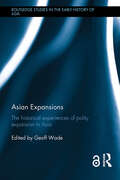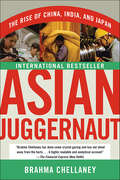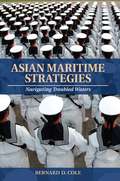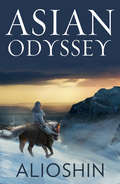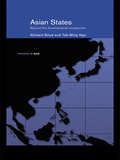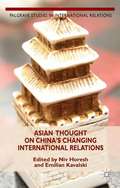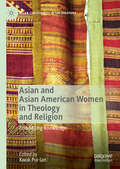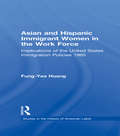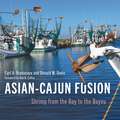- Table View
- List View
Asian Discourses of Rule of Law
by Randall PeerenboomRule of law is one of the pillars of the modern world, and widely considered necessary for sustained economic development, the implementation of democracy and the protection of human rights. It has however emerged in Western liberal democracies, and some people question how far it is likely to take root fully in the different cultural, economic and political context of Asia. This book considers how rule of law is viewed and implemented in Asia. Chapters on France and the USA provide a benchmark on how the concept has evolved, is applied and is implemented in a civil law and a common law jurisdiction. These are then followed by twelve chapters on the major countries of East Asia, and India, which consider all the key aspects of this important issue.
Asian Economies: History, Institutions, and Structures
by Jamus Jerome LimAn insightful and thorough exploration of the economies of Asia In Asian Economies: History, Institutions and Structure, seasoned economist and professor Jamus Jerome Lim provides a comprehensive discussion and incisive analysis of the economies of Asia. In addition to discussing the sharp contrasts between the region’s three major economies—China, India, and Japan—Lim also provides an overview of the rise of the Dragon economies of the East, to the resource-rich economies of the West. The book adopts a unique approach to the treatment of these economies, weaving in aspects of these countries’ economic geography and history, their idiosyncratic institutions and structures, along with providing a comparative and international perspective. The book offers: Careful emphasis on the geographic preconditions and enduring legacy of economic history on the contemporary and future prospects of each of the countries and regions discussed within Examinations of the importance of the political and economic institutions, as well as market and industrial structures, in shaping the trajectories of the economies considered in the book Discussions of the dramatic differences and similarities between the Asian economies, as well as how these differences shape these economies’ interactions with the rest of the worldPerfect for undergraduate and graduate students of economics, Asian Economies will also earn a place on the bookshelves of business and finance professionals seeking to understand the economies of the world’s most diverse and dynamic region.
Asian English: Histories, Texts, Institutions (Asia-Pacific and Literature in English)
by Steve Clark Myles Chilton Yukari YoshiharaContesting the idea that the study of Anglophone literature and literary studies is simply a foreign import in Asia, this collection addresses the genealogies of textual critique and institutionalized forms of teaching of English language and literature in Asia through the 19th and 20th centuries, along with an examination of how its present options and possible future directions relate to these historical contexts. It argues that the establishment of Anglophone literature in Asia did not simply “happen”: there were extra-literary and -academic forces at work, inserting and domesticating in Asian universities both the English language and Anglo-American literature, and their attendant cultural and political values. Offering new perspectives for ongoing conversations surrounding the globalization of Anglophone literature in literary and cultural studies, the book also considers the practicalities of teaching both the language and its canon of classic texts, and that the historical formation and shape of English studies in Asia offers lessons that relate not only to the discipline but also may be applied to the humanities as a whole.
Asian Expansions: The Historical Experiences of Polity Expansion in Asia (Routledge Studies in the Early History of Asia)
by Geoff WadeAsia as we know it today is the product of a wide range of polity expansions over time. Recognising the territorial expansions of Asian polities large and small through the last several millennia helps rectify the fallacy, long-held and deeply entrenched, that Asian polities have been interested only in the control of populations, not in expanding their command of territory. In countering this misapprehension, this book suggests that Asian polities have indeed been concerned with territorial control and expansion over time, whether for political or strategic advantage, trade purposes, defence needs, agricultural expansion or increased income through taxation. The book explores the historical experiences of a set of polity expansions within Asia, specifically in East and Southeast Asia, and, by examining the motivations, mechanisms, processes, validations and limitations of these Asian territorial expansions, reveals the diverse avenues by which Asian polities have grown. The chapters draw on these historical examples to highlight the connections between Asian polity expansion and centralised political structures, and this aids in a broader and more comprehensive understanding of Asian political practice, both past and present. Through these chapter studies and the integrative introduction, the book interrogates key concepts such as imperialism and colonialism, and the applicability and relevance of such terminology in Asian contexts, both historical and contemporary. Comparisons and contrasts with European historical expansions are also suggested. This book will be welcomed by students and scholars of Asian history, as well as by those with an interest in Asian interactions, international relations, polity expansion, Asia--Europe historical comparisons and globalisation.
Asian Foreign Policy in a Changing Arctic: The Diplomacy of Economy and Science at New Frontiers
by Aki TonamiThis book examines the growing interest by Asian states, which are normally considered as 'outsiders' in the Arctic governance system. Whilst existing research asserts that Asian states are mostly interested in the economic aspect of the changing Arctic, including its mineral and fossil sources and the opening up of new sea routes, the book argues that the relation between Asian states and the Arctic is much more complex and dynamic, grounded in their unique perspective on national security and the role of economic development in securing their national interests.
Asian Histories and Heritages in Video Games (ISSN)
by Paweł Schreiber Yowei Kang Yang, Kenneth C. C. Michał Mochocki Jakub MajewskiThis book explores the representations of national Asian histories in digital games. Situated at the intersection of regional game studies and historical game studies, this book offers chapters on histories and heritages of Japan, China, Iran, Iraq, Taiwan, South Korea, Indonesia, Singapore, Turkey, and Russia.The volume looks beyond the diversity of the local histories depicted in games, and the audience reception of these histories, to show a diversity of approaches which can be used in examining historical games– from postcolonialism to identity politics to heritage studies. It demonstrates various methodological approaches to historical/regional game studies: case studies of nationally produced historical games that deal with local history, studies of media reception of history/heritage-themed games, text-mining methods studying attitudes expressed by players of such games, and educational perspectives on games in teaching cultural heritage. Through the lens of videogames, the authors explore how nations struggle with the legacies of war, colonialism and religious strife that have been a part of nation-building - but also how victimized cultures can survive, resist, and sometimes prevail.Appealing primarily to scholars in the fields of game studies, heritage studies, postcolonial criticism, and media studies, this book will be particularly useful for the subfields of historical game studies and postcolonial game studies.
Asian Juggernaut: The Rise of China, India, and Japan
by Brahma ChellaneyIn Asian Juggernaut, the revelatory and important International Bestseller by Brahma Chellaney, a renowned authority on Asia’s political and economic development offers an incisive and insightful analysis of the region’s pivotal role on the world stage. Examining the rise of China, India, and Japan as preeminent powers and their key position in the global future, Asian Juggernaut is a book that must be read by anyone interested in the shape of tomorrow’s world.
Asian Maritime Strategies
by Bernard D. ColeThis book is concerned with both the national security concerns of Asian maritime nations and the security of the Asian maritime commons. These are defined as the Pacific and Indian Oceans and associated seas, bays, and gulfs, with their included sea lines of communication (SLOCs). The most useful geographical designation for maritime Asia is the "Indo-Pacific." Bernard Cole provides both a survey of the maritime strategies of the primary nations of the Indo-Pacific region and an evaluation of the domestic and international politics that drive those strategies. The United States, Canada, Russia, Japan, North Korea, South Korea, China, the Philippines, Brunei, Indonesia, Vietnam, Singapore, Malaysia, Myanmar, India, Pakistan, Iran, the smaller Indian Ocean and Persian Gulf states are all surveyed and analyzed. The United States, Japan, China, and India not surprisingly draw the most attention, given their large modern navies and distant strategic reach. The author concludes that the United States remains the dominant maritime power in this huge region, stretching from Canada to the Persian Gulf, despite its lack of a traditionally strong merchant marine. U.S. maritime power remains paramount, due primarily to its dominant navy. The Chinese naval modernization program deservedly receives a good deal of public attention, but Cole argues that on a day-to-day basis the Japanese Maritime Self-Defense Force, as its navy is named, is the most powerful maritime force in Far Eastern waters, while the modernizing Indian Navy potentially dominates the Indian Ocean. In fact, a focus of this work is the exemplary description of all the region's navies, with the author noting the naval arms race that is underway, particularly in the area of submarine acquisition. Cole is careful to couch this phenomenon in the regional concerns about Chinese naval expansion and the desire to ensure a continued, massive U.S. naval presence. The current naval developments in the region evince elements of a naval arms race, but lack the coherent maritime strategies to make naval developments dangerous to regional peace and security. Most telling will be whether United States power and focus remain on the region, while adjusting to continued Chinese maritime power in a way acceptable to both nations. No other current or recent work provides such a complete description of the Indo-Pacific region's navies and maritime strategies, while analyzing the current and future impact of those forces.
Asian Nationalisms Reconsidered
by Jeff KingstonNationalism appears to be rising in a renascent Asia and stoking tensions, aspirations, and identity politics while amplifying grievances and raising questions about prospects in what is touted as the Asian century. This book provides a broad overview and introduction to nationalism in Asia. Leading experts in their fields succinctly convey key information and critical analysis useful to students in a range of courses across disciplines. Part I presents thematic chapters, mostly cross-national studies, that elucidate the roots and consequences of nationalism in these societies and the varying challenges they confront. Part II presents concise country case studies in Asia, providing an overview of what is driving contemporary nationalism and surveys the domestic and international implications. Approaching Asia from the perspective of nationalism facilitates a comparative, interdisciplinary analysis that helps readers better understand each society and what the ramifications of nationalism are for contemporary Asians, and the worlds that they (and we) participate in. Asian Nationalisms Reconsidered is an invaluable textbook for undergraduate courses and graduate seminars related to international relations, Asian Studies, political science, government, foreign policy, peace and conflict, and nationalism.
Asian Odyssey
by Dmitri AlioshinAsian Odyssey, first published in 1940, is the autobiographical account of Dmitri Alioshin’s experiences in Siberia and Mongolia in the chaotic, often extremely violent times following the Russian Revolution. Alioshin, an officer in the Imperial Army, served in the army of the White Russians under General Kolchak and Baron von Ungern-Sternberg, then in the communist Red Army, and later joined the ill-fated American Expeditionary force as an interpreter under General Graves. Alioshin’s account makes for fascinating reading as he describes the bitter fighting between communist and Imperial forces, the shifting loyalties of the soldiers, the plundering of captured villages, the harsh landscape including a trek across the Gobi Desert, and the ways of life of the Mongols, Cossacks, and other groups. The book ends with Alioshin returning to his father’s home in Harbin, China, but little is known about Alioshin’s subsequent life. Included are 10 pages of illustrations.
Asian Philosophies
by John M. KollerThis book offers a sympathetic examination of major Asian philosophical and religious traditions, including Vedic thought, the Jain vision, Samkhya, the Vendata, Indian theism, Islam, Buddhism, Madhyamaka, Zen, Confucianism, Taoism, Neo-Confucianism, and contemporary thought.
Asian Place, Filipino Nation: A Global Intellectual History of the Philippine Revolution, 1887–1912 (Columbia Studies in International and Global History)
by Nicole CuUnjieng AboitizThe Philippine Revolution of 1896–1905, which began against Spain and continued against the United States, took place in the context of imperial subjugation and local resistance across Southeast Asia. Yet scholarship on the revolution and the turn of the twentieth century in Asia more broadly has largely approached this pivotal moment in terms of relations with the West, at the expense of understanding the East-East and Global South connections that knit together the region’s experience. Asian Place, Filipino Nation reconnects the Philippine Revolution to the histories of Southeast and East Asia through an innovative consideration of its transnational political setting and regional intellectual foundations.Nicole CuUnjieng Aboitiz charts turn-of-the-twentieth-century Filipino thinkers’ and revolutionaries’ Asianist political organizing and proto-national thought, scrutinizing how their constructions of the place of Asia connected them to their regional neighbors. She details their material and affective engagement with Pan-Asianism, tracing how colonized peoples in the “periphery” of this imagined Asia—focusing on Filipinos, but with comparison to the Vietnamese—reformulated a political and intellectual project that envisioned anticolonial Asian solidarity with the Asian “center” of Japan. CuUnjieng Aboitiz argues that the revolutionary First Philippine Republic’s harnessing of transnational networks of support, activism, and association represents the crucial first instance of Pan-Asianists lending material aid toward anticolonial revolution against a Western power. Uncovering the Pan-Asianism of the periphery and its critical role in shaping modern Asia, Asian Place, Filipino Nation offers a vital new perspective on the Philippine Revolution’s global context and content.
Asian Reader (3rd Edition)
by Jennifer Taylor Ed FrameOne of the most important aspects of teaching is having accessible a textbook, in one volume, reflecting the subject matter being taught. In an attempt to provide such a work, this volume is an anthology of writings that are appropriate to the needs of a course in Asian humanities.
Asian Religions in America: A Documentary History
by Stephen Prothero Thomas A. TweedArticles about Asian religions in America now and in the past.
Asian Settler Colonialism: rom Local Governance to the Habits of Everyday Life in Hawaii
by Jonathan Y. Okamura Candace FujikaneAsian Settler Colonialism is a groundbreaking collection that examines the roles of Asians as settlers in Hawai‘i. Contributors from various fields and disciplines investigate aspects of Asian settler colonialism to illustrate its diverse operations and impact on Native Hawaiians. Essays range from analyses of Japanese, Korean, and Filipino settlement to accounts of Asian settler practices in the legislature, the prison industrial complex, and the U.S. military to critiques of Asian settlers’ claims to Hawai‘i in literature and the visual arts.
Asian Slaves in Colonial Mexico
by Tatiana Seijas"During the late sixteenth and seventeenth centuries, countless slaves from culturally diverse communities in the Indian subcontinent and Southeast Asia journeyed to Mexico on the ships of the Manila Galleon. Upon arrival in Mexico, they were grouped together and categorized as chinos. In time, chinos came to be treated under the law as Indians (the term for all native people of Spain's colonies) and became indigenous vassals of the Spanish crown after 1672. The implications of this legal change were enormous: as Indians, rather than chinos, they could no longer be held as slaves. By tracking these individuals' complex journey from the bondage of the Manila slave market to the freedom of Mexico City streets, Tatiana Seijas challenges commonly held assumptions about the uniformity of the slave experience in the Americas and shows that the history of coerced labor is necessarily connected to colonial expansion and forced global migration"--
Asian States: Beyond the Developmental Perspective (Politics in Asia)
by Richard Boyd Tak-Wing NgoA team of international leading experts provide a much needed re-examination of the theoretical claims and the empirical foundation of developmental state theory. Asian States argues that regardless of the merits of the developmental state as an explanation of economic growth, it falls far short of being an adequate theory of the state in Asia. The contributors critically review claims about agency, state-society and state-market relations that shape developmental projects. It broadens the analysis of state involvement in developmental projects and considers the variety of political and social bases for state projects across East and Southeast Asia in a theoretically sensitive, thematic and empirically rich way.
Asian Thought On China’s Changing International Relations
by Niv Horesh Emilian KavalskiAt the end of the Cold War, commentators were pondering how far Western ideas would spread; today, the debate seems to be how far Chinese ideas will reach. This volume examines Chinese international relations thought and practices, identifying the extent to which China's rise has provoked fresh geo-strategic and intellectual shifts within Asia.
Asian Tourism Sustainability (Perspectives on Asian Tourism)
by Yue Ma Ann Selvaranee BalasingamThis book brings together a collection of chapters that investigate sustainable tourism development in different Asian contexts; from stakeholders’ perspectives, existing issues in the market, as well as the impacts of COVID-19 on tourism. It highlights the importance of tourism sustainability in Asia. Specifically, this book examines these themes by examples related to Asian tourism such as; social-cultural impact of sustainable growth, environmental constraints and policies, community engagement, moral limits of the market, stakeholders’ participation in tourism development, the hindered interaction between foreign tourists and local community, impact of the pandemic and proposed ways forward. This edited volume substantiates this by using evidence of quantitative, qualitative and mixed methods approaches aligned with empirical data to show sustainable efforts and impacts. This book is of interest to researchers and practitioners as it offers timely understandings of sustainable tourism from multiple perspectives within the Asian context.
Asian Video Cultures: In the Penumbra of the Global
by Bhaskar Sarkar Joshua NevesThe contributors to this volume theorize Asian video cultures in the context of social movements, market economies, and local popular cultures to complicate notions of the Asian experience of global media. Whether discussing video platforms in Japan and Indonesia, K-pop reception videos, amateur music videos circulated via microSD cards in India, or the censorship of Bollywood films in Nigeria, the essays trace the myriad ways Asian video reshapes media politics and aesthetic practices. While many influential commentators overlook, denounce, and trivialize Asian video, the contributors here show how it belongs to the shifting core of contemporary global media, thereby moving conversations about Asian media beyond static East-West imaginaries, residual Cold War mentalities, triumphalist declarations about resurgent Asias, and budding jingoisms. In so doing, they write Asia's vibrant media practices into the mainstream of global media and cultural theories while challenging and complicating hegemonic ideas about the global as well as digital media. Contributors. Conerly Casey, Jenny Chio, Michelle Cho, Kay Dickinson, Bishnupriya Ghosh, Feng-Mei Heberer, Tzu-hui Celina Hung, Rahul Mukherjee, Joshua Neves, Bhaskar Sarkar, Nishant Shah, Abhigyan Singh, SV Srinivas, Marc Steinberg, Chia-chi Wu, Patricia Zimmerman
Asian Waters: The Struggle Over the Indo-Pacific and the Challenge to American Power
by Humphrey Hawksley&“Seamlessly connects geography, history and great power intrigue across the entire Indo-Pacific region, increasingly the fulcrum of world history.&” —James Clad, Director, Asian Security Programs at the American Foreign Policy Council In the sphere of future global politics, no region will be as hotly contested as the Asia-Pacific, where great power interests collide amid the mistrust of unresolved conflicts and disputed territory. This is where authoritarian China is trying to rewrite international law and challenge the democratic values of the United States and its allies. The lightning rods of conflict are remote reefs and islands from which China has created military bases in the 1.5-million-square-mile expanse of the South China Sea, a crucial world trading route that this rising world power now claims as its own. No other Asian country can take on China alone. In Asian Waters, award–winning foreign correspondent Humphrey Hawksley breaks down the politics—and tensions—that he has followed through this region for years. Reporting on decades of political developments, he has witnessed China&’s rise to become one of the world&’s most wealthy and militarized countries, and delivers in Asian Waters the compelling narrative of this most volatile region. Can the United States and China handle the changing balance of power peacefully? Do Japan, the Philippines, South Korea, and Taiwan share enough common purpose to create a NATO-esque multilateral alliance? Does China think it can even become a superpower while making an enemy of America? If so, how does it plan to achieve it? Asian Waters delves into these topics and more as Hawksley presents the most comprehensive and accessible analysis ever of this region.
Asian and Asian American Women in Theology and Religion: Embodying Knowledge (Asian Christianity in the Diaspora)
by Pui-Lan KwokThis book presents personal narratives and collective ethnography of the emergence and development of Asian and Asian American women’s scholarship in theology and religious studies. It demonstrates how the authors’ religious scholarship is based on an embodied epistemology influenced by their social locations. Contributors reflect on their understanding of their identity and how this changed over time, the contribution of Asian and Asian American women to the scholarship work that they do, and their hopes for the future of their fields of study. The volume is multireligious and intergenerational, and is divided into four parts: identities and intellectual journeys, expanding knowledge, integrating knowledge and practice, and dialogue across generations.
Asian and Hispanic Immigrant Women in the Work Force: Implications of the United States Immigration Policies since 1965 (Garland Studies in the History of American Labor)
by Fung-Yea HuangFirst Published in 1997. Routledge is an imprint of Taylor & Francis, an informa company.
Asian-Americans in the Old West (Cornerstones of Freedom)
by Gail SakuraiWhen gold was discovered in California in 1848, word spread quickly throughout the United States, Europe, and Asia. Soon, the United States was inundated with immigrants who sought their fortunes. The influx of Asians into the West resulted in controversial rulings by Congress and in racial discrimination by ordinary Americans. However, many Asians made lasting contributions to the settlement of the West -- from working on the transcontinental railroad to the cultivation of the Bing cherry. This book chronicles the achievements of the talented and diverse group of people known as Asian-Americans.
Asian-Cajun Fusion: Shrimp from the Bay to the Bayou (America's Third Coast Series)
by Carl A. Brasseaux Donald W. DavisShrimp is easily America’s favorite seafood, but its very popularity is the wellspring of problems that threaten the shrimp industry’s existence. Asian-Cajun Fusion: Shrimp from the Bay to the Bayou provides insightful analysis of this paradox and a detailed, thorough history of the industry in Louisiana. Dried shrimp technology was part of the cultural heritage Pearl River Chinese immigrants introduced into the Americas in the mid-nineteenth century. As early as 1870, Chinese natives built shrimp-drying operations in Louisiana’s wetlands and exported the product to Asia through the port of San Francisco. This trade internationalized the shrimp industry. About three years before Louisiana’s Chinese community began their export endeavors, manufactured ice became available in New Orleans, and the Dunbar family introduced patented canning technology. The convergence of these ancient and modern technologies shaped the evolution of the northern Gulf Coast’s shrimp industry to the present. Coastal Louisiana’s historic connection to the Pacific Rim endures. Not only does the region continue to export dried shrimp to Asian markets domestically and internationally, but since 2000 the region’s large Vietnamese immigrant population has increasingly dominated Louisiana’s fresh shrimp harvest. Louisiana shrimp constitute the American gold standard of raw seafood excellence. Yet, in the second decade of the twenty-first century, cheap imports are forcing the nation’s domestic shrimp industry to rediscover its economic roots. “Fresh off the boat” signs and real-time internet connections with active trawlers are reestablishing the industry’s ties to local consumers. Direct marketing has opened the industry to middle-class customers who meet the boats at the docks. This “right off the boat” paradigm appears to be leading the way to reestablishment of sustainable aquatic resources. All-one-can-eat shrimp buffets are not going to disappear, but the Louisiana shrimp industry’s fate will ultimately be determined by discerning consumers’ palates.



